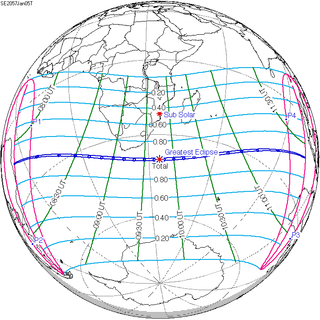| Solar eclipse of January 5, 2057 | |
|---|---|
| Type of eclipse | |
| Nature | Total |
| Gamma | −0.2837 |
| Magnitude | 1.0287 |
| Maximum eclipse | |
| Duration | 149 s (2 min 29 s) |
| Coordinates | 39°12′S 35°12′E / 39.2°S 35.2°E |
| Max. width of band | 102 km (63 mi) |
| Times (UTC) | |
| Greatest eclipse | 9:47:52 |
| References | |
| Saros | 142 (25 of 72) |
| Catalog # (SE5000) | 9634 |
A total solar eclipse will occur at the Moon's descending node of orbit on Friday, January 5, 2057,[1] with a magnitude of 1.0287. A solar eclipse occurs when the Moon passes between Earth and the Sun, thereby totally or partly obscuring the image of the Sun for a viewer on Earth. A total solar eclipse occurs when the Moon's apparent diameter is larger than the Sun's, blocking all direct sunlight, turning day into darkness. Totality occurs in a narrow path across Earth's surface, with the partial solar eclipse visible over a surrounding region thousands of kilometres wide. Occurring about 1.6 days after perigee (on January 3, 2057, at 20:00 UTC), the Moon's apparent diameter will be larger.[2]
This eclipse and May 20, 2050 are the next two total solar eclipses in which the Moon's shadow will trace a path that fails to hit land anywhere on Earth. Totality will begin 125 miles east of Belmonte in Brazil, then traverse southeast through the Atlantic Ocean where it will miss the Cape of Good Hope in South Africa by 250 miles, before winding northeast and concluding in the Indian Ocean 500 miles south of Java island. However, a partial solar eclipse will be visible for parts of eastern South America, Southern Africa, Antarctica, Southeast Asia, and western Australia.
- ^ "January 5, 2057 Total Solar Eclipse". timeanddate. Retrieved 17 August 2024.
- ^ "Moon Distances for London, United Kingdom, England". timeanddate. Retrieved 17 August 2024.
